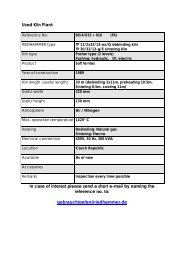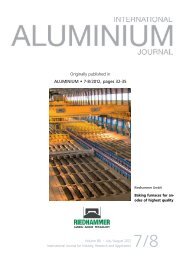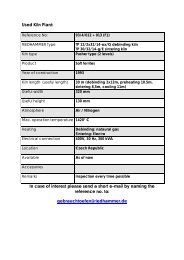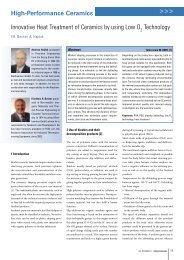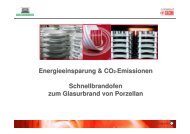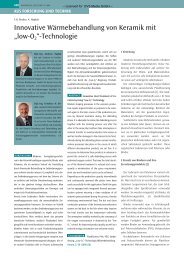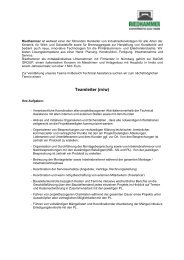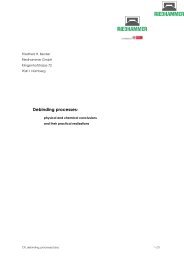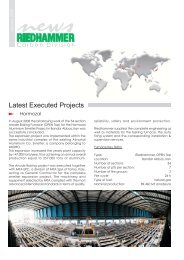State of the Art Anode Baking - Riedhammer
State of the Art Anode Baking - Riedhammer
State of the Art Anode Baking - Riedhammer
Create successful ePaper yourself
Turn your PDF publications into a flip-book with our unique Google optimized e-Paper software.
<strong>State</strong> <strong>State</strong> <strong>State</strong> <strong>State</strong> <strong>of</strong> <strong>of</strong> <strong>of</strong> <strong>of</strong> <strong>the</strong> <strong>the</strong> <strong>the</strong> <strong>the</strong> <strong>Art</strong> <strong>Art</strong> <strong>Art</strong> <strong>Art</strong> <strong>Anode</strong> <strong>Anode</strong> <strong>Anode</strong> <strong>Anode</strong> <strong>Baking</strong><br />
<strong>Baking</strong><br />
<strong>Baking</strong><br />
<strong>Baking</strong><br />
Authors:<br />
Frank Goede<br />
Business Director – Carbon Division<br />
frank.goede@riedhammer.de<br />
Thomas Janousch<br />
Senior Engineer<br />
Manager Business Development – Carbon Division<br />
thomas.janousch@riedhammer.de<br />
RIEDHAMMER GmbH<br />
Klingenh<strong>of</strong>str. 72<br />
D-90411<br />
Nuremberg, Germany
Table <strong>of</strong> contents<br />
Introduction<br />
<strong>Anode</strong> <strong>Baking</strong> Facility<br />
<strong>State</strong>-<strong>of</strong> <strong>State</strong> <strong>of</strong>-<strong>the</strong> <strong>the</strong>-art art BAKING FURNACE<br />
AFS – Auto Firing System<br />
R&D<br />
Advanced BAKING FURNACE<br />
FTC – Fume Treatment Center<br />
<strong>Anode</strong> Handling<br />
Conclusions<br />
1st Middle East Carbon Course 2010 in Dubai, 27-29 April 2010 Page 2
Introduction<br />
<strong>Anode</strong> Quality:<br />
High impact on:<br />
net carbon consumption<br />
aluminum production cost<br />
Theoretical consumption:<br />
1 MT Al 334 Kg <strong>of</strong> Carbon<br />
(with an efficiency <strong>of</strong> 100%)<br />
<strong>Anode</strong> consumption as quantification <strong>of</strong> anode performance kinetics<br />
(Source: Meier, Fischer, Müller “Influence <strong>of</strong> <strong>Anode</strong> Quality on Aluminum Production Cost”)<br />
1st Middle East Carbon Course 2010 in Dubai, 27-29 April 2010 Page 3
Introduction<br />
<strong>Baking</strong> process: Most expensive step in <strong>the</strong> production <strong>of</strong> anodes<br />
<strong>Anode</strong> properties influenced by baking process:<br />
CO 2 reactivity<br />
Thermal conductivity<br />
Air reactivity<br />
Mechanical strength<br />
1st Middle East Carbon Course 2010 in Dubai, 27-29 April 2010 Page 4
<strong>Anode</strong> <strong>Baking</strong> Facility<br />
Plant layout<br />
FTC – Fume Treatment Center<br />
<strong>Anode</strong> storage area:<br />
green + baked<br />
Furnace building<br />
Stacking cranes<br />
<strong>Baking</strong> furnace<br />
+ Firing system<br />
FTA – Multi<br />
purpose cranes<br />
Conveyors<br />
1st Middle East Carbon Course 2010 in Dubai, 27-29 April 2010 Page 5
<strong>Anode</strong> <strong>Baking</strong> Facility<br />
Case study: typical layout for 150.000 MT/a<br />
<strong>Baking</strong> furnace<br />
FTC – Fume treatment<br />
center<br />
AFS – Auto Firing System<br />
<strong>Anode</strong> cleaning and<br />
grouping station<br />
<strong>Anode</strong> storage area<br />
<strong>Anode</strong> conveyors<br />
1st Middle East Carbon Course 2010 in Dubai, 27-29 April 2010 Page 6
<strong>State</strong>-<strong>of</strong> <strong>State</strong> <strong>of</strong>-<strong>the</strong> <strong>the</strong>-art art <strong>Baking</strong> Furnace<br />
Targets<br />
Proven design<br />
Low CAPEX with high productivity<br />
Low energy consumption<br />
Low maintenance<br />
Optimum product quality<br />
Environment aspects / HSE<br />
Reliability<br />
1st Middle East Carbon Course 2010 in Dubai, 27-29 April 2010 Page 7
<strong>State</strong>-<strong>of</strong> <strong>State</strong> <strong>of</strong>-<strong>the</strong> <strong>the</strong>-art art <strong>Baking</strong> Furnace<br />
Typical Furnace Performance Parameters <strong>of</strong> a <strong>Riedhammer</strong><br />
OPEN Top Furnace with firing system <strong>of</strong> R&D Carbon<br />
Max. baking temperature (flue gases): 1.300 °C<br />
<strong>Anode</strong> final baking temperature (average): 1.100 ±20 °C<br />
Fuel consumption: 1,8 – 2,2 GJ/tba<br />
<strong>Baking</strong> scrap: ≤ 0,5 %<br />
Packing material consumption (CPC): 8 – 10 kg/tba<br />
Expected flue wall service life: 150 – 180 cycles (8 to 10 years)<br />
Furnace substructure service life: > 400 cycles<br />
Productivity (throughput per pit): up to 850 kg/h<br />
1st Middle East Carbon Course 2010 in Dubai, 27-29 April 2010 Page 8
<strong>State</strong>-<strong>of</strong> <strong>State</strong> <strong>of</strong>-<strong>the</strong> <strong>the</strong>-art art <strong>Baking</strong> Furnace<br />
Maintenance strategy<br />
General repair works (renewal<br />
<strong>of</strong> all inner flue walls)<br />
1st Middle East Carbon Course 2010 in Dubai, 27-29 April 2010 Page 9
AFS – Auto Firing System<br />
AFS : characteristics<br />
Optimized temperature pr<strong>of</strong>iles for furnace<br />
operation<br />
Excellent temperature homogeneity<br />
Reduced consumption figures<br />
Heat-up<br />
rate<br />
Maximum combustion <strong>of</strong> volatile matters<br />
reduced emissions<br />
Furnace and operative related safety<br />
aspects<br />
Example <strong>of</strong> baking pr<strong>of</strong>ile<br />
to illustrate key parameters<br />
to be optimized for high<br />
quality anodes (courtesy <strong>of</strong><br />
R&D Carbon)<br />
1st Middle East Carbon Course 2010 in Dubai, 27-29 April 2010 Page 10
AFS – Auto Firing System<br />
AFS : characteristics<br />
Cross section <strong>of</strong> a fire-group, indicating main<br />
components <strong>of</strong> <strong>the</strong> AFS<br />
Flue gas<br />
ring mains<br />
Cross over<br />
3D view <strong>of</strong> a flue wall cross section with<br />
indication <strong>of</strong> flow pattern<br />
Exhaust<br />
manifold<br />
Measuring<br />
ramp<br />
Burner<br />
ramps<br />
Preheating Main fire Cooling<br />
Fire advance direction<br />
Cooling ramps Unloading Loading<br />
1st Middle East Carbon Course 2010 in Dubai, 27-29 April 2010 Page 11
AFS – Auto Firing System<br />
AFS: layout (based on R&D Carbon firing system)<br />
1st Middle East Carbon Course 2010 in Dubai, 27-29 April 2010 Page 12<br />
Optional
R&D<br />
CFD – Computational Fluid Dynamics<br />
Optimization <strong>of</strong> flow distribution<br />
Application <strong>of</strong> numerical methods and algorithms<br />
to solve and analyze problems that involve fluid<br />
flows inside a flue wall <strong>of</strong> <strong>the</strong> ABF:<br />
Targets:<br />
ensure a lowest possible pressure drop <strong>of</strong><br />
<strong>the</strong> flue wall<br />
temperature distribution with minimum<br />
variation<br />
With <strong>the</strong> support <strong>of</strong> R&D Carbon and in collaboration with <strong>the</strong> University <strong>of</strong> Applied Science <strong>of</strong> Nuremberg<br />
1st Middle East Carbon Course 2010 in Dubai, 27-29 April 2010 Page 13
R&D<br />
CFD – Computational Fluid Dynamics<br />
courtesy <strong>of</strong> R&D Carbon<br />
The flue wall design has a substantial impact on <strong>the</strong><br />
anode quality, leading to a lower carbon consumption in<br />
<strong>the</strong> reduction cell, also with improvement <strong>of</strong><br />
environmental aspects.<br />
Optimization <strong>of</strong> flow distribution<br />
To improve anode quality, it’s important to achieve a<br />
good flow distribution in order to maximize<br />
temperature homogeneity inside a pit.<br />
courtesy <strong>of</strong> R&D Carbon<br />
1st Middle East Carbon Course 2010 in Dubai, 27-29 April 2010 Page 14
ADVANCED <strong>Baking</strong> Furnace<br />
Requirements <strong>of</strong> <strong>the</strong> aluminum industry<br />
1. Increased furnace throughput<br />
(MT/CAPEX)<br />
2. <strong>Baking</strong> <strong>of</strong> “longer” anodes<br />
3. Increased refractory lifetime<br />
4. Lower energy consumption<br />
Faster fire cycle<br />
More pits per section (> 8 pits)<br />
Pit design / Pit height<br />
Refurbishment <strong>of</strong> existing furnaces<br />
Furnace re-engineering<br />
Material engineering<br />
Maintenance: procedures + effort<br />
In contrast to higher furnace throughput<br />
Not a primary goal<br />
Influenced by several parameters<br />
1st Middle East Carbon Course 2010 in Dubai, 27-29 April 2010 Page 15
ADVANCED <strong>Baking</strong> Furnace<br />
CASE 1: Increased furnace throughput<br />
a. Faster fire cycle<br />
b. Number <strong>of</strong> pits per<br />
section<br />
c. Combination <strong>of</strong> “a + b”<br />
7 sections heat-up configuration<br />
6 x 28 h = 7 x 24 h + 16%<br />
More negative pressure required<br />
Higher specific fuel consumption<br />
up to 65.000 tba / a<br />
> 8 pits per section<br />
up to 10 pits are feasible<br />
building span > 42.500 mm<br />
up to 70.500 tba / a<br />
> 10 pits / 7 sections heat-up<br />
up to 82.500 tba / a<br />
1st Middle East Carbon Course 2010 in Dubai, 27-29 April 2010 Page 16
ADVANCED <strong>Baking</strong> Furnace<br />
CASE 2: “Longer Longer” anodes<br />
Pit design / Pit height<br />
Increased pit height leads to<br />
- higher energy consumption and<br />
- extended baking / soaking time<br />
Retr<strong>of</strong>it <strong>of</strong> existing furnaces to cope with new anode dimensions<br />
1st Middle East Carbon Course 2010 in Dubai, 27-29 April 2010 Page 17
ADVANCED <strong>Baking</strong> Furnace<br />
CASE 3: Increased refractory lifetime<br />
Furnace redesign:<br />
Optimization <strong>of</strong> bake furnace design<br />
Location <strong>of</strong> expansion joints<br />
Cross over modification<br />
Material engineering / development:<br />
Use <strong>of</strong> refractory with improved characteristics<br />
Use <strong>of</strong> top blocks with lower <strong>the</strong>rmal conductivity<br />
Maintenance:<br />
Optimized refractory maintenance<br />
Permanent servicing <strong>of</strong> expansion joints<br />
1st Middle East Carbon Course 2010 in Dubai, 27-29 April 2010 Page 18
ADVANCED <strong>Baking</strong> Furnace<br />
CASE 4: Lower energy consumption<br />
In contrast to higher furnace throughput for <strong>the</strong> following<br />
reasons:<br />
Increased pit height (but also pit width)<br />
Faster fire cycle<br />
Not <strong>the</strong> primary goal, ra<strong>the</strong>r a consequence <strong>of</strong> o<strong>the</strong>r<br />
important requirements:<br />
<strong>Anode</strong> quality<br />
Furnace lifetime (less maintenance)<br />
O<strong>the</strong>r parameters influencing <strong>the</strong> energy consumption:<br />
Furnace design (flue wall cavity)<br />
Final baking temperature<br />
<strong>Anode</strong> pitch content<br />
Furnace production rate<br />
Furnace operation and condition<br />
1st Middle East Carbon Course 2010 in Dubai, 27-29 April 2010 Page 19
ADVANCED <strong>Baking</strong> Furnace<br />
Furnace performance parameters (typical)<br />
Max. baking temperature (flue gases): 1.300 °C<br />
<strong>Anode</strong> final baking temperature (average): 1.100 ±20 °C<br />
Fuel consumption: 2,1 – 2,5 GJ/tba<br />
<strong>Baking</strong> scrap: ≤ 0,5 %<br />
Packing material consumption (CPC): 8 – 10 kg/tba<br />
Expected flue wall service life: > 180 cycles (8 to 10 years)<br />
Furnace substructure service life: > 400 cycles<br />
Productivity (throughput per pit): up to 900 kg/h (future 940 kg/h)<br />
1st Middle East Carbon Course 2010 in Dubai, 27-29 April 2010 Page 20
FTC – Fume Treatment Center<br />
FTC – Introduction<br />
Characteristics<br />
Low maintenance<br />
Low energy consumption<br />
Redundancy: 100%<br />
Highest environmental<br />
standard<br />
1st Middle East Carbon Course 2010 in Dubai, 27-29 April 2010 Page 21
FTC – Fume Treatment Center<br />
FTC – Main aspects<br />
DSS – Dry scrubbing<br />
system<br />
RTO – Regenerative<br />
Thermal Oxidizer<br />
Low SO x *<br />
**<br />
H xC y<br />
High SO x *<br />
1st Middle East Carbon Course 2010 in Dubai, 27-29 April 2010 Page 22<br />
HF<br />
SO x<br />
***<br />
Dust<br />
* SO X level depending mainly on:<br />
Type <strong>of</strong> fuel:<br />
- natural gas: low SO X<br />
- Heavy fuel oil: high SO X<br />
Characteristics <strong>of</strong> packing coke<br />
Firing system operation: too high final baking temperature can lead to desulphurization effect<br />
** Abatement level <strong>of</strong> H xC y can be substantially improved by reducing temperature <strong>of</strong> inlet flue<br />
gases (105–110°C) in filter system by means <strong>of</strong> e.g. water injection (cooling tower). By relatively<br />
high S content, formation <strong>of</strong> sulphuric acid (by temperatures below acid dew point) can lead to<br />
corrosion problems <strong>of</strong> filter steel structures.<br />
*** SO X abatement: marginal adsorption by Al 2O 3, but fur<strong>the</strong>r release in <strong>the</strong> reduction cells.
<strong>Anode</strong> Handling<br />
FTA – Furnace Tending Assembly<br />
Characteristics<br />
<strong>State</strong>-<strong>of</strong>-<strong>the</strong>-art MPC:<br />
- Handling <strong>of</strong> anodes<br />
- Packing / unpacking <strong>of</strong> fill material<br />
- Displacement <strong>of</strong> AFS equipment<br />
High level <strong>of</strong> availability<br />
1st Middle East Carbon Course 2010 in Dubai, 27-29 April 2010 Page 23
<strong>Anode</strong> Handling<br />
Storage with ASC (<strong>Anode</strong> Stacking Cranes)<br />
Characteristics: ASC<br />
Fully automatic<br />
„Intelligent“ ASC - linked<br />
with MPC, anode handling<br />
system and green mill<br />
Characteristics: <strong>Anode</strong> Store<br />
Highest safety<br />
standards<br />
Flexible storage<br />
Automatic anode<br />
cleaning system<br />
1st Middle East Carbon Course 2010 in Dubai, 27-29 April 2010 Page 24
<strong>Anode</strong> Handling<br />
Conveyors and cleaning station<br />
<strong>Anode</strong> lift<br />
<strong>Anode</strong> cleaning<br />
station<br />
To rodding shop<br />
Baked<br />
10’000 t<br />
Green<br />
10’000 t<br />
Green anodes from<br />
green mill<br />
Green anodes<br />
Furnace conveyor<br />
Baked anodes<br />
1st Middle East Carbon Course 2010 in Dubai, 27-29 April 2010 Page 25
<strong>Anode</strong> Handling<br />
Conveyors and cleaning station<br />
Furnace conveyor<br />
Baked anode<br />
storage conveyor<br />
Tilting and weighing<br />
Cleaning station<br />
De-dusting unit<br />
Baked anode lift<br />
De-grouping station<br />
with down-ender and<br />
turntable<br />
Grouping station with<br />
pusher and up-ender<br />
Green anode lift<br />
<strong>Anode</strong> weighing and<br />
measuring<br />
Green anode storage<br />
conveyor<br />
1st Middle East Carbon Course 2010 in Dubai, 27-29 April 2010 Page 26
Conclusion<br />
Smelter Requirements<br />
<strong>Riedhammer</strong> and R&D Carbon are joining forces and<br />
continuously promoting equipment and process<br />
enhancements in order to provide solutions for increasing<br />
and challenging requirements <strong>of</strong> <strong>the</strong> Smelter, mainly in terms<br />
<strong>of</strong>:<br />
Higher productivity<br />
Better anode quality with minimum variation<br />
Environmental aspects: lower emissions<br />
Extended brickwork lifetime<br />
Overall energy consumption<br />
1st Middle East Carbon Course 2010 in Dubai, 27-29 April 2010 Page 27
Conclusions<br />
Final Words<br />
<strong>Riedhammer</strong> GmbH and R&D Carbon Ltd. are<br />
cooperating closely to provide <strong>the</strong> industry<br />
with improved concepts and technologies for<br />
future cost competitive anode plants.<br />
1st Middle East Carbon Course 2010 in Dubai, 27-29 April 2010 Page 28




